AI×Crypto Intersection: In-depth Analysis of Five AI Layer1 Projects

Reprinted from panewslab
03/13/2025·1MAuthor: Louis, Core Contributor
Editor: Biteye Core Contributor Denise
With the rapid development of AI technology, traditional blockchain architectures can no longer meet the high-performance computing and complex data processing needs for AI applications, which has led to the rise of Layer 1 blockchain platforms optimized for AI. They show diversified characteristics in terms of technical architecture, application scenarios and business models.
This study deeply analyzes five leading AI Layer1s, Bittensor, Vana, Kite AI, Nillion and Sahara.
01. Bittensor: Decentralized AI Network Infrastructure
As an early explorer in the field of blockchain AI, Bittensor is committed to building an open decentralized artificial intelligence collaboration network.
Its goal is to break the centralized barriers in traditional AI research and development, so that more participants can contribute and benefit together.
Unlike traditional centralized AI systems (such as OpenAI and other companies), Bittensor has created an open peer-to-peer ecosystem where participants can receive corresponding rewards based on their contribution to the network.
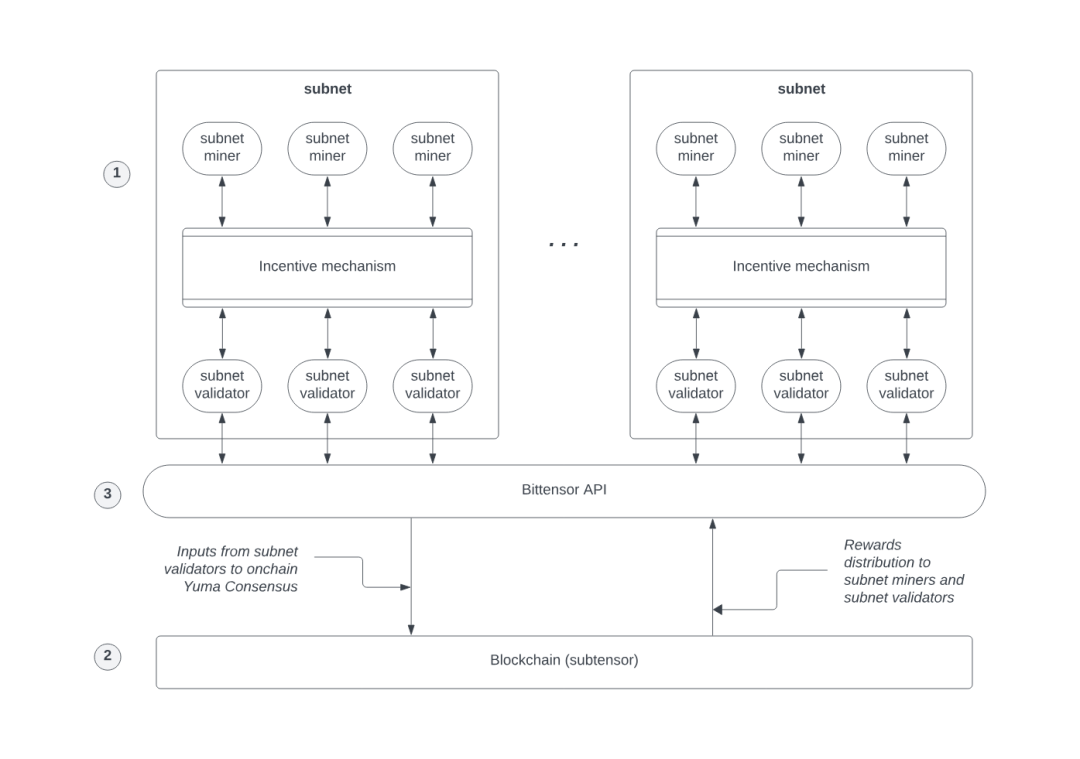
Bittensor's technical architecture adopts a two-layer structure design:
- Root Network (main network): Responsible for the coordination, verification of the entire system and the issuance and management of TAO tokens, and is the center of the entire network resource allocation.
- Subnet ecosystem: Each subnet is like an independent AI laboratory, developing professional solutions for specific AI application scenarios and proving its value in market competition.
This design allows Bittensor to take into account the stability of the overall network and the professionalism of various fields, providing a flexible infrastructure for the development of decentralized AI.
Ecological development progress
- The number of subnets has expanded from 32 in the early stage to more than 64, covering a variety of AI application scenarios such as text generation, transaction signals, and data annotation.
- The base of active users has reached 140,000, doubled compared with the previous year
- The total valuation of the subnet market exceeded US$100 million, and the daily trading volume remained at around US$45 million.
- Institutional participation has increased significantly. The well-known fund Grayscale has included TAO in its decentralized AI fund, and its weight has been adjusted to 29.55%.
These data suggest that Bittensor is gaining recognition from more and more market participants and its ecosystem is entering a healthy development track.
Bittensor's recent dTAO (dynamic TAO) system upgrade is an important innovation in its economic model. The core of this upgrade is to optimize the allocation mechanism of token TAO, from resource allocation methods that rely on subjective judgment of verifiers to a more market-oriented allocation mechanism, so that resources can flow more accurately to those truly competitive subnets.
Bittensor's original economic model exposed several key issues in actual operation:
1. The evaluation mechanism lacks objectivity: As the number of subnets increases, it is difficult for validators to comprehensively and objectively evaluate the actual value of each subnet, and the allocation efficiency gradually decreases.
2. Imbalance of power structure: Many validators are also subnet operators. This overlap of roles can easily lead to conflicts of interest. Verifiers may prefer subnets they participate in, and even private transactions occur.
3. Participation barrier: It is difficult for ordinary TAO holders to directly affect the network's resource allocation decisions, and their power is over-concentrated in the hands of a few validators.
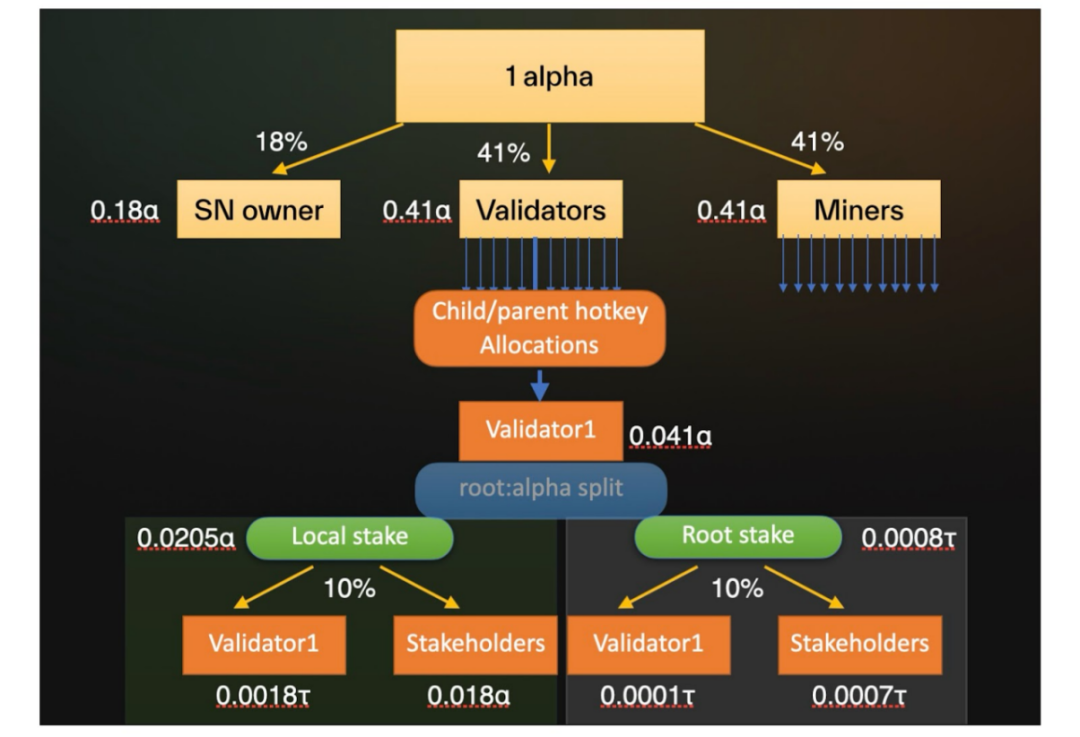
In order to solve these problems, dTAO upgrade introduces a dynamic resource allocation system based on market mechanisms.
This system transforms each subnet into an independent economic unit, driving resource allocation through the actual needs of users. Its core innovation is the subnet token (Alpha token) mechanism:
- Operating principle: Users can obtain Alpha tokens issued by each subnet by staking TAO. These tokens represent users' support for specific subnets.
- Resource allocation logic: The market price of the Alpha token becomes a signal to measure the strength of the subnet demand. At the beginning, the price of the alpha token is the same, and there is only 1 TAO and 1 alpha token in each pool. With the addition of liquidity of two tokens in the subnet, the price of alpha tokens will also change accordingly. The emission of TAO is proportional to all tokens based on the subnet token price. Subnets with higher prices will obtain more TAO allocation, thereby realizing automatic optimization of resources.
This mechanism significantly improves the efficiency and fairness of resource allocation, makes the value of TAO tokens more stable, and provides more ways for ordinary users to participate in network governance.
The most active subnets currently include:
- Subnet No. 4 Targon: AI reasoning services focused on text generation, characterized by fast response speed and low cost
- 64 subnet Chutes: Provides API interfaces for various LLMs, allowing developers to build and deploy AI applications on the Bittensor network
- PTN: Focus on the financial field, and encourages miners to generate accurate trading signals through reward mechanisms, covering various financial markets such as foreign exchange and cryptocurrencies.
- Subnet No. 52 Dojo: Do data annotation, and encourage users to earn tokens through data annotation. Enter Yzi Labs announced an investment in its parent company Tensorplex.
02. Vana: Data sovereignty and value reconstruction platform
The Vana project focuses on solving a core issue in today's digital economy: ownership and value distribution of personal data. In the current Internet ecosystem, most of the user's data is monopolized and controlled by large technology companies, while users who truly create this data rarely benefit from it. Vana’s innovation is to build an ecosystem where users truly own and control their own data, while being able to earn financial returns from it.
As an EVM-compatible Layer 1 blockchain network, Vana's technical architecture includes five core components:
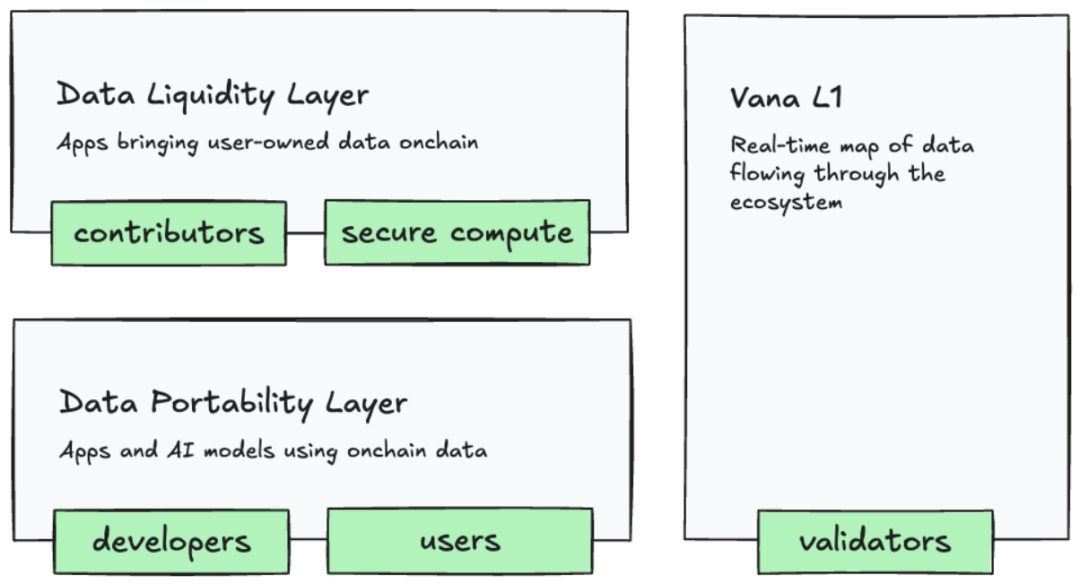
- Data Liquidity Layer: This is the core of the Vana network, which realizes incentives, aggregation and verification of data assets through data liquidity pools (DLP). Each DLP is a smart contract dedicated to aggregate specific types of data assets, such as social media data, browsing history, etc.
- Data Portability Layer: Ensure user data can be easily transferred between different applications and AI models, enhancing data usage flexibility.
- Universal Connectome: Track the real-time data flow within the entire ecosystem to form a data ecosystem to ensure the transparency of the system.
- Unmanaged Data Storage: An important innovation in Vana is its unique way of managing data. The user's raw data will not be linked, but will be selected by the user on his own storage location, such as a cloud server or personal device, which ensures that the user has full control over his own data.
- Application ecosystem: Based on data, Vana builds an open application ecosystem where developers can use the data accumulated by DLP to build various innovative applications, including AI applications, and data contributors can receive dividend rewards from these applications.
This design allows Vana to create a more fair data value allocation mechanism while protecting user data privacy, providing an important data foundation for the development of decentralized AI.
Latest developments
Vana's financing and cooperation expansion continue to advance:
- In February 2025, YZi Labs announced a strategic investment in Vana, and Binance founder CZ joined as an advisor.
- In terms of ecological construction, Vana has built data projects covering multiple fields from social media data to financial forecasting data, including: Finquarium (financial forecasting data), GPT Data DAO (ChatGPT chat data), Reddit Data DAO (Reddit user data), Volara (Twitter data), Flirtual (dating data), etc.
- Vana recently organized a hackathon event during Eth Denver, providing a prize pool of up to $50,000 to inspire developers to build DataDAO and Vana data-based AI applications to further expand its ecosystem.
These progress shows that Vana is actively building a complete ecosystem around data ownership and value monetization, and its development momentum is worthy of attention.
03. Kite AI: Technical breakthrough in AI native public chain
Kite AI is a native Layer 1 blockchain project focused on the AI field, built on the Avalanche framework. It is committed to solving various challenges faced by traditional blockchains when processing AI assets, especially how to achieve the clear rights and incentives of AI data, models and agent contributions. Kite AI proposes four core technological innovations:
1. PoAI consensus mechanism: Proof of Attributed Intelligence is the first consensus mechanism created by Kite AI. It accurately tracks the value contribution of data, models and AI agents through a verifiable contribution record system on-chain. The project designed a dynamic reward pool mechanism to distribute income according to the contribution ratio, effectively solving problems such as "data black box" and "model plagiarism" in the traditional AI economy.
2. Combinable AI subnet: Kite AI adopts a modular architecture to support developers to build an industry-specific AI collaboration ecosystem on demand. For example, in the medical subnet, patient data can be encrypted and authorized to pharmaceutical companies for AI model research and development, and the income will be distributed to data subjects, model developers and subnet maintainers in a certain proportion, creating a win-win ecological environment for all parties.
3. AI native execution layer: Kite AI is building an on-chain AI native execution layer that specializes in handling AI computing tasks such as inference, embedding and fine-tuning/training. Through this layer, users can authorize smart contract wallets to perform inference calls and interact with the model. This execution layer not only supports blockchain transactions and state changes, but also integrates a confidential computing environment (such as a trusted execution environment TEE) to ensure data security and privacy protection during the computing process.
4. Decentralized data engine: Kite AI ensures that data creators gain fair benefits in their AI workflow. The platform has built-in scale blocks that comply with GDPR/CCPA and other regulations, meeting data privacy requirements around the world and reducing the compliance costs of developers.
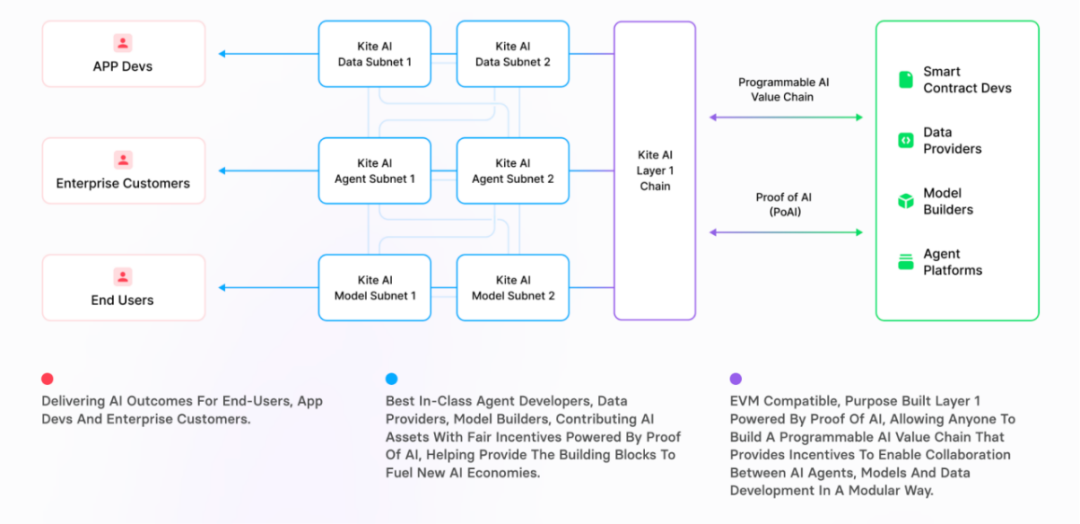
These technological innovations allow Kite AI to create a more fair and transparent value distribution environment for AI developers and data providers, and promote the decentralized development of AI technology.
Current development status
Kite AI launched the Incentive Test Network on February 6, 2025, which is the first AI native Layer 1 sovereign blockchain test network. The test network performed well after it was launched:
- Less than 70 hours after the test network was launched, the number of connected wallets exceeded 100,000. As of now, a total of 1.95 million wallets have been added to the incentive test network V1, of which more than 1 million wallets have interacted with AI agents, with a total number of calls exceeding 115 million.
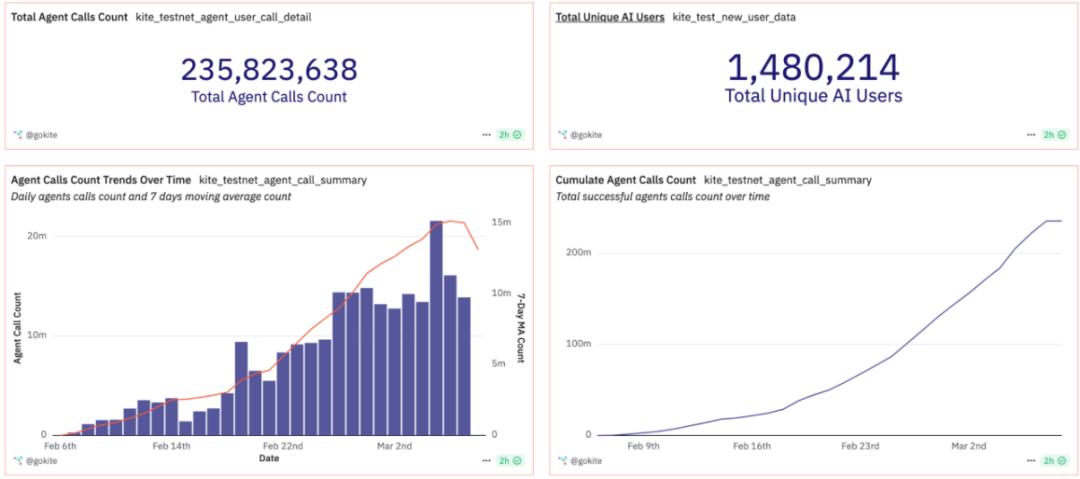
- The project has a strong background and is built by an experienced Silicon Valley team. The co-founders all have deep technical leadership experience in the field of artificial intelligence. They have worked in top technology companies such as Uber, Salesforce, and Databricks. The core team members come from industry-leading companies such as Google, BlackRock, Uber, and NEAR Foundation, and have academic backgrounds from top universities such as MIT and Harvard.
- In terms of capital support, the project has received investment from top institutions such as General Catalyst, Hashed, Hashkey, Samsung Next, and has established technical cooperation relationships with Eigenlayer, Sui, Avalanche, AWS, etc.
- As Avalanche’s selection committee member in the InfraBUILDL (AI) program, Kite AI plays an active role in promoting the development of the Avalanche’s artificial intelligence ecosystem, a collaboration aimed at building Avalanche into a leading blockchain for AI applications.
- With the global data economy expected to exceed US$70 billion in 2025, Kite AI is expected to become an important infrastructure for data rights confirmation and monetization, and its development potential is worth looking forward to.
04. Nillion: Frontier Exploration of Privacy Computing
Through its unique "blind computing" technology, Nillion is redefining how sensitive data is processed and opening up new ways for future digital privacy protection.
Nillion is a decentralized public network based on an innovative cryptographic primitive called Nil Message Compute (NMC), allowing network nodes to operate in a non-traditional blockchain way. Founded in November 2021, the project is led by forward-looking innovators such as Alex Page and Andrew Masanto, aims to create a system that can safely process high-value data without exposing sensitive details.
The core advantage of Nillion is its "blind computing" capability—a process that allows storage, transmission and processing throughout the data life cycle to remain encrypted. Its technical architecture integrates a variety of cutting-edge privacy protection technologies:
- Multi-party computing (MPC): enables multiple nodes to collaborate on computing functions without leaking their own private inputs, and realizes common computing in the absence of data sharing.
- Fully homomorphic encryption (FHE): allows direct operation of encrypted data, ensuring that the data remains encrypted from beginning to end, and providing privacy protection throughout the process.
- Zero Knowledge Proof (ZKP): Provides a method to verify computing without the need to disclose any underlying data, enhancing the credibility of the system.
- Nada Language: This is a domain-specific language designed specifically for creating secure MPC programming. It simplifies the development process of privacy-protected applications and reduces the developer's learning curve.
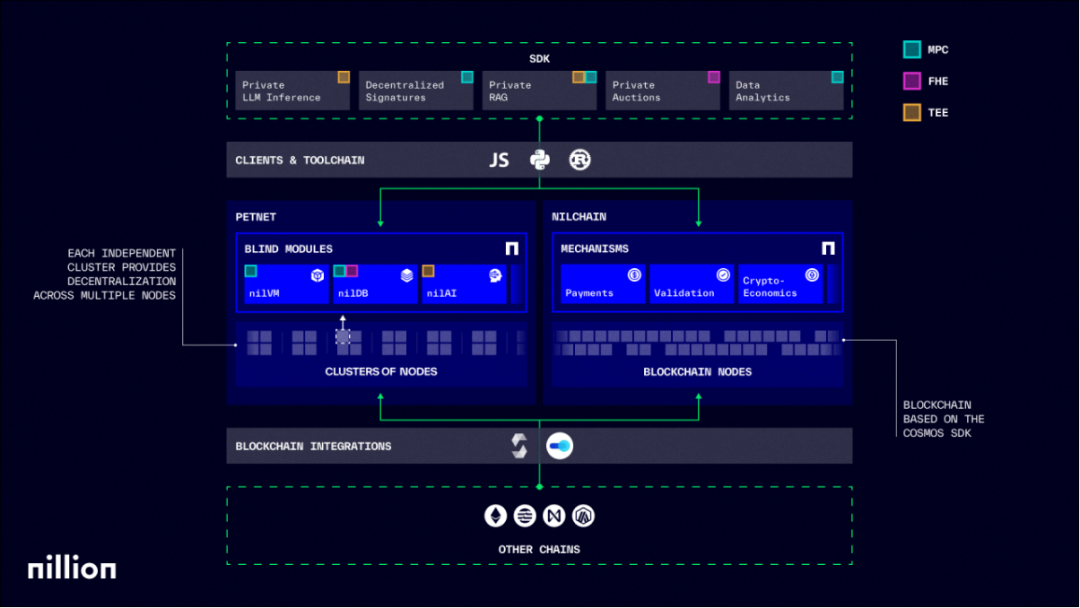
Nillion's network architecture consists of three main layers: the processing layer (responsible for security computing), the coordination layer (NilChain, managing inter-node communication) and the connection layer (connecting external systems as gateways). This multi-layer architecture allows Nillion to provide powerful computing power while protecting data privacy, meeting the needs of various privacy-sensitive scenarios.
Latest development process
According to the latest information, the development of the Nillion network is steadily advancing:
- The Nillion mainnet is scheduled to be launched in March 2025 (this month). Nillion's total tokens are 1 billion and are expected to be distributed when the main network is started.
- In terms of financing, Nillion completed a $25 million financing led by Hack VC on October 30, 2024. Investors include well-known institutions such as HashKey Capital and Animoca Brands, as well as angel investors from projects such as Arbitrum, Worldcoin and Sei. This round of financing has brought Nillion's cumulative financing amount to US$45 million, providing sufficient financial support for the long-term development of the project.
- In terms of ecological expansion, Nillion has established integrated relationships with multiple mainstream public chains such as NEAR Protocol, Aptos, Arbitrum, Mantle, Sei, etc. Through its partnership with NEAR Protocol, Nillion aims to enhance privacy tools that enable developers to innovate more effectively in the DeFi space.
- In terms of the AI ecosystem, Nillion has established cooperation with multiple AI-related projects, including Ritual, Crush AI, Skillful AI, Virtuals Protocol, etc. For example, Virtuals Protocol is the largest multimodal AI proxy protocol at present. By cooperating with Nillion, it uses its secure computing infrastructure to support private training and inference of AI models, achieving a perfect combination of AI and privacy.

05. Sahara AI: A platform for building a new economy of AI assets
Project development
The core concept of Sahara AI is to build a "human AI collaboration network" that enables ordinary users, developers and enterprises to participate in the creation, deployment and monetization of AI assets. Through this collaboration model, Sahara AI hopes to lower the entry barrier for AI so that every participant can share the dividends of industry growth. The project has successfully secured a total of $43 million in financing led by Binance Labs, Polychain Capital and Pantera Capital.
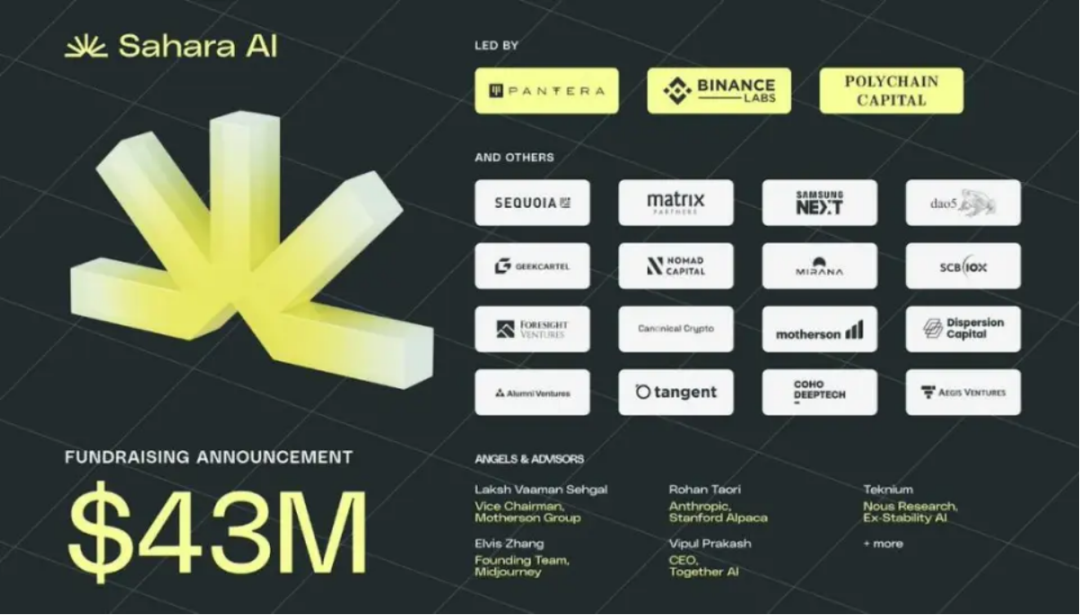
The platform's technical architecture consists of three key components:
1.Sahara Blockchain: The foundation for providing secure, transparent transactions and efficient AI lifecycle management for the ecosystem
2. AI infrastructure: distributed collaborative training and service capabilities that support advanced algorithms and computing frameworks
3.Sahara AI Marketplace: Decentralized trading center for AI assets
Together, these components form a complete ecosystem that supports the entire process from data collection and annotation to model training, deployment and monetization.
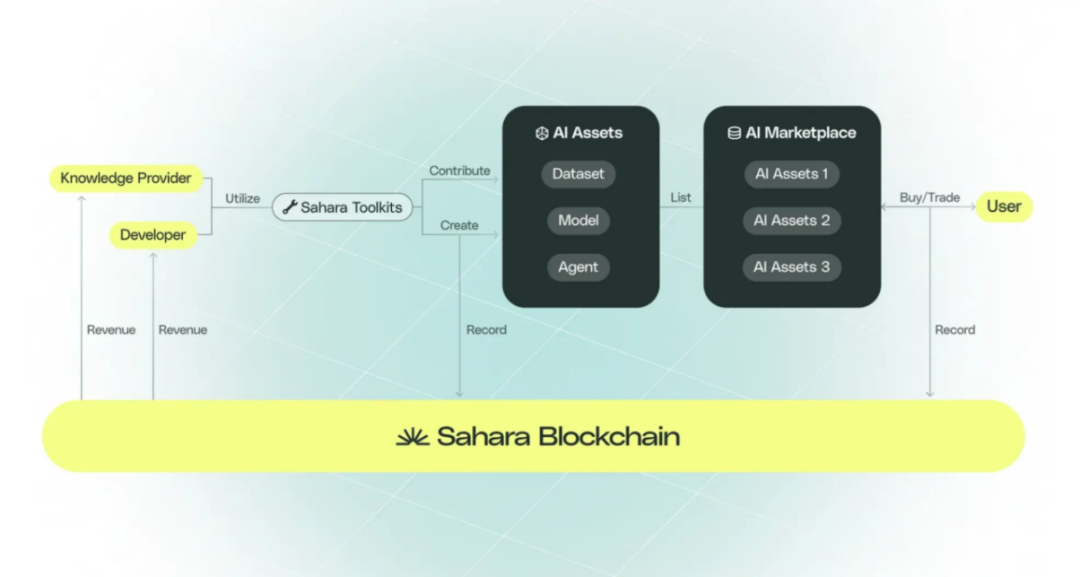
Latest development process
The Sahara AI project is in a rapid development stage, and its test network has gone through several important stages:
- In December 2024, Sahara AI launched the first phase of data service platform Beta version test network, attracting more than 780,000 users to apply, of which more than 10,000 candidates were awarded the first batch of participation qualifications. At this stage, participants can contribute and receive rewards to the AI ecosystem by completing data collection, optimization, and labeling tasks.
- In February 2025, Sahara AI launched the second phase of the testnet, expanding the platform's contributor base and introducing additional reward opportunities. This stage further strengthens users' participation in shaping the future of decentralized AI.
- The latest development is that Sahara AI announced that it will launch a public test network called "SIWA" on March 10, 2025. This is considered the last major test before the Sahara AI mainnet launch and TGE, and may also be the last chance for participants to earn airdrop rewards (called "points").
Sahara AI has released its 2024-2025 roadmap, which includes multiple key nodes:
- Q4 2024: A data service platform and test network have been launched, and users can receive rewards through data collection and labeling.
- Q1 2025: AI Marketplace is launched, providing development tools and data service expansion functions, supporting model development, training and deployment, and introducing early access plans.
- Q2 2025: Launch the Sahara Studio tool suite, covering model training, deployment and workflow management, further optimizing the developer experience.
- Q3 2025: Sahara Chain main network is released to provide a secure and transparent on-chain infrastructure for large-scale decentralized AI, while supporting assetization and transactions of data and models.
On March 1, 2025, Sahara AI launched its incubator program, aiming to discover and support the world's most promising AI x Web3 innovation projects. The plan focuses on two major tracks: AI infrastructure and AI applications, and teams with MVP and above are welcome to participate. The successfully selected projects will have the opportunity to fully access the Sahara AI ecosystem, obtain exclusive technical support, market expansion resources and investment opportunities.
06. Summary
AI Layer 1 is in a critical stage of rapid evolution. This emerging track is reconstructing the underlying architecture of AI technology through decentralized infrastructure. From data rights confirmation to computing resource allocation, from model training to application deployment, these platforms are breaking through the limitations of traditional centralized AI systems and building a more open, transparent and efficient technology ecosystem. In the future, this track will continue to promote technological innovation and promote the evolution of artificial intelligence to a more decentralized and collaborative development direction.

